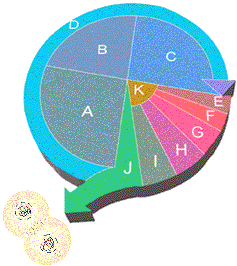
Press here to go back to the readings. press
2. The answer is is "c" . Identify the processes which occur during
the various stages of the cell cycle in your notes. Most of your
body cells are in the G1 stage. Many cells remain in this stage for their
entire life.
Press here to go back to the readings. press
3. The answer is "c". DNA replicates during the synthesis stage
preparing the cell for mitosis.
Press here to go back to the readings. press
4. The answer is "a". All working cells are in this stage. The cells
you studied in miniunit Beta were in the G1 stage of interphase.
Press here to go back to the readings. press
5. The answer is "a". Cytokinesis occurs at the end of the mitotic
stage "K". (figure below)
Press here to go back to the readings. press

6. The answer is "b". Each mitotic cell cycle produces two new
cells containing the same number of chromosomes as the mother cell.
Press here to go back to the readings. press
7. The answer is "c". Both daughter cells will have the same number
of chromosomes as the original mother cell.
Press here to go back to the readings. press
8. The answer is "d". During the synthesis stage the DNA is replicated;
therefore the G2 stage will have twice the number of DNA molecules. During
the G-1 stage each "chromosome" consists of a single DNA molecule
and during the G-2 stage each "chromosome" consists of two DNA molecules.
Press here to go back to the readings. press
9. The answer is "c". Count the number of DNA molecules and chromosomes
in the figure below.
G1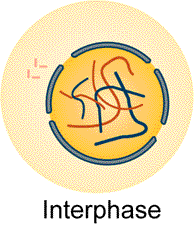 G2
G2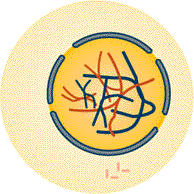
Press here to go back to the readings. press
10. The answer is "d". Most of your epithelial cells are working cells.
Press here to go back to the readings. press
11. The answer is "d". The reason for the 92 : 46 answer is: during
the G2 stage the DNA has doubled but remains attached; therefore the chromosome
number remains the same but consists of two parts (chromatids) instead
of a single DNA molecule.
Press here to go back to the readings. press
12. The correct answer is "c". G1 stage followed by the S stage where
DNA replicates.
Press here to go back to the readings. press
13. The answer is "a". There are two original DNA molecules in
the G1 stage containing the genes Tt and gg. After DNA replicates during
the synthesis stage, the G2 DNA molecules will have replicated of all genes
- TTtt and gggg. The figure below represents the G2 stage.
G2 pair 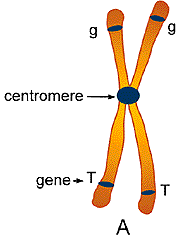
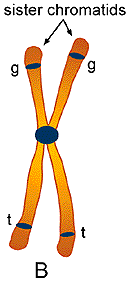
Press here to go back to the readings. press
14. The correct answer is "a".
Press here to go back to the readings. press
15. The answer is "a". There are two chromosomes and each chromosome
consists of two chromatids.


Press here to go back to the readings. press
Press here to go back to the readings. press
17. The answer is "a". Only one centromere per chromosome.

Press here to go back to the readings. press
18. The answer is "b". Three homologous pair - one short pair,
one medium pair and one long pair.
Press here to go back to the readings. press
19. The correct answer is "c". Homologous pair have the same gene sequence
and must be of the same length.
Press here to go back to the readings. press
20. The correct answer is "b". Each chromatid contains one kinetochore;
therefore two kinetochores per chromosome.
.
Press here to go back to the readings. press
21. The correct answer is "b".
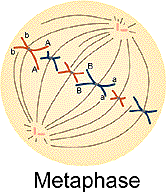
Press here to go back to the readings. press
22. The correct answer is "b". "1" is long and "3" is short.
Press here to go back to the readings. press
23. The answer is "b". The centromere of the chromosome splits and
sister chromatids are pulled to opposite poles.
Press here to go back to the readings. press
24. The correct answer is "a". Yes sister chromatids are being pulled
to opposite poles.
Press here to go back to the readings. press
25.
Press here to go back to the readings.
26. The answer is "c". Each cell contains six chromosomes.
Press here to go back to the readings. press
27. The correct answer is "b". This is the final stage of mitosis.
Each cell contains homologous pair of chromosomes, but each chromosomes
is "single".
Press here to go back to the readings. press
27a.

Press here to go back to the readings. press
28. The correct answer is "b". No! Mitosis only produces two
daughter cells.
Press here to go back to the readings. press
29. The correct answer is "a". True
Press here to go back to the readings. press
Press here to go back to the readings. press
31. The answer is is "b" false. The daughter cells are genetically
alike and genetically like the mother cell.
Press here to go back to the readings. press
32.
Press here to go back to the readings. press
33. The correct answer is "a".
Press here to go back to the readings. press
34. The correct answer is "c".
Press here to go back to the readings. press
35. The correct answer is "d" - 40.
Press here to go back to the readings. press
36. The correct answer is "b". You may want to go back to miniunit
Beta and compare centrioles with cilia and basal bodies.
c 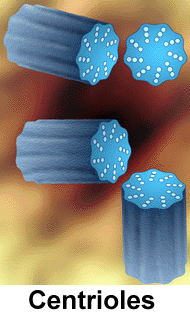
Press here to go back to the readings. press
37. The answer is "d". Protein microtubules.
Press here to go back to the readings. press